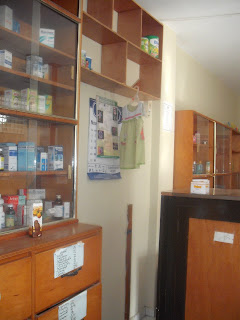






We got up early to sort through our supplies: food, antibiotics and bandages, etc. to bring to the clinic. At 10 am we left for the clinic. We had to take a detour through a market since the bridge that was to take us to Blanchard was deemed unsafe. The van wound its way along the river where there seemed to be a settlement in the midst of piles of refuse, women washing their clothes with water from the river that looked gray. This scene reminded me very much of the the slum close to River Road in Nirobi, Kenya. The heat was intense and throngs of people were selling and buying.
On the way to the clinic, we saw some tents at the Agriculture Department and people were lining for food. across the street was a bank and the line there was quite long as well.
The road to the clinic was winding and dusty. There were quite a number of houses that were destroyed by the earthquake and make-shift tents were rigged up next to these houses.
We arrived at the clinic which looked unfinished but the clinic rooms were cheerful and I like the white tiles which made the rooms so much brighter. Immediately when we arrived we were asked to see an old woman with an old stroke and another recent stroke a few days ago and a set of twins. We really could not do too much for this lady but did get an IV started in the afternoon for some hydration while she was lying in the tent.
One of my very first patients was a grandmother with crushed injuries to her calf. She was seen at another clinic and had some stitches. She walked in with a walking stick fashioned from the branch of a coconut frond, accompanied by her daughter who lost two of her children, a 3 and a 6-year-olds. She began to cry when I asked her about it through my interpreter, Benite. They also lost their home and needed food. Her wound was quite ugly and I cleaned it as much as she would allow me.
There were many more patients to see and I lost track of how many we saw that day. Almost everyone that we asked had lost some loved ones, homes or their homes were too unsafe to live in. They lived outside their homes or what was left of them in make-shift tents made out of sheets, plastic sheets or cardboard. There was a tremendous amount of sadness weighing on the shoulders of these Haitians.
When I was in Africa, It struck me that the African people are very resilient and always seem happy in the face of adversity. The People of Haiti seem to display the same kind of resiliency that I observed in Africans. How people continue to have the desire to live in situations that look completely hopeless is beyond comprehension. They remind me of the Zimbabwean refugees I met in Musina, South Africa.
















































